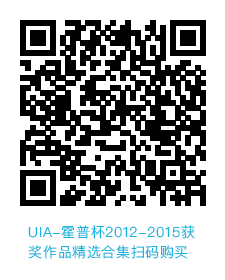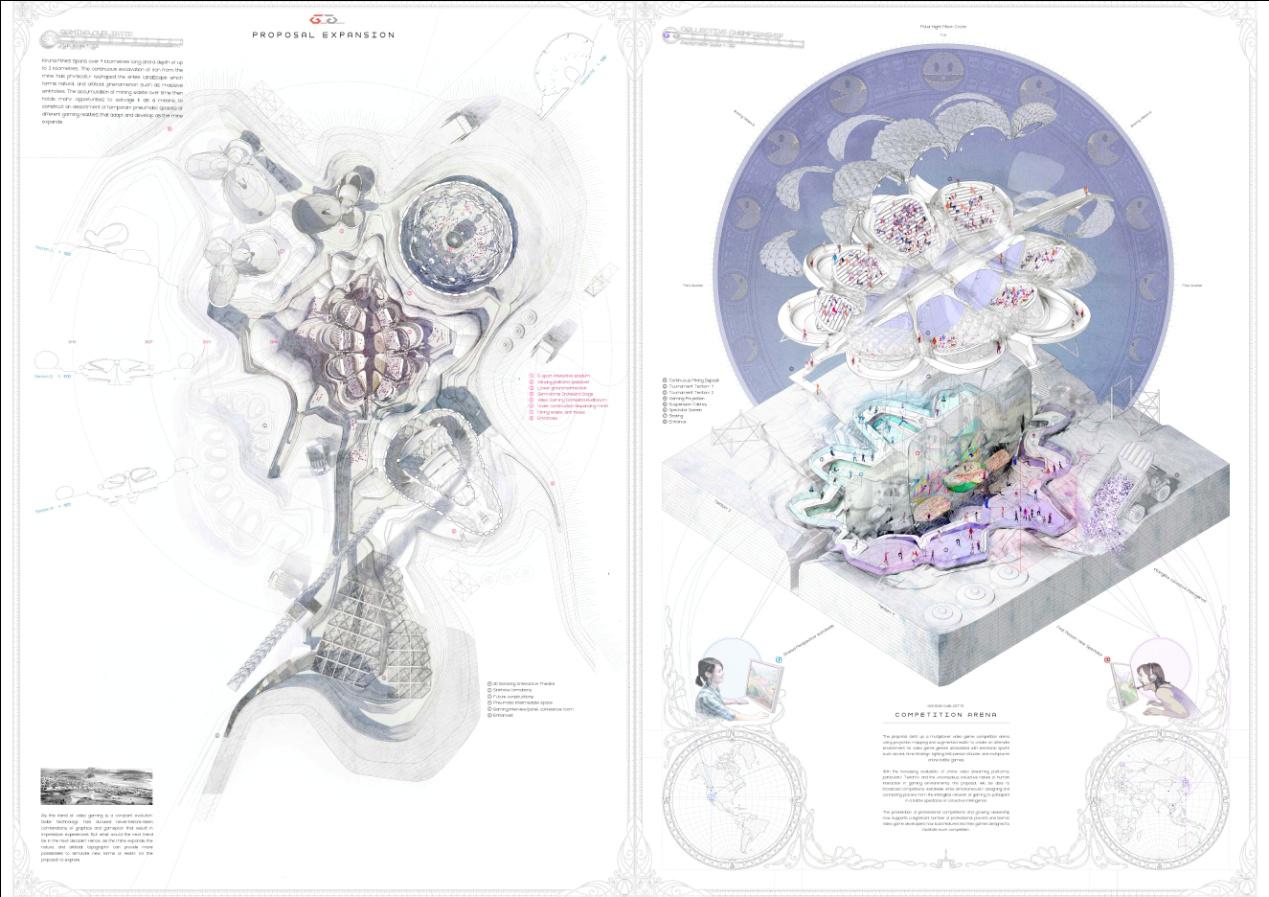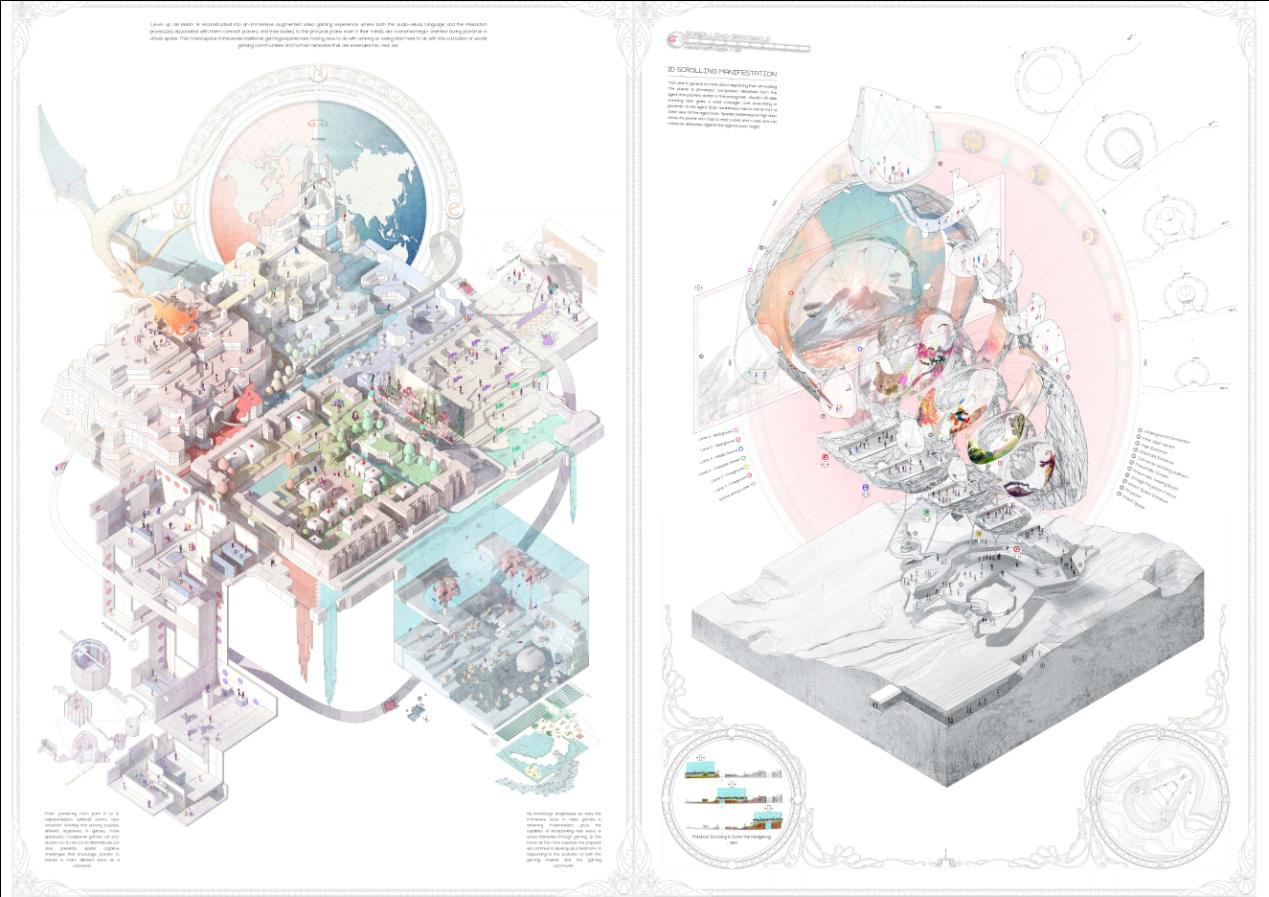

TOPIC: Transformation: Place, Tradition and Modernism in Conceptual Unity and Diversity
Students:Christopher Yah Chuen Shen
Project :Gaming Oubliette
Tutors :Cristina Díaz Moreno 、 Efrén García Grinda
School :Architectural Association School of Architecture
“Level up” as reality is reconstructed into an immersive, augmented video gaming experience; where both the audio-visual language and the interaction processes associated with them connect players and their bodies to the physical plane even if their minds are overwhelmingly allured during playtime in virtual space. With the spread of online role-playing games, this hybrid space transcends traditional gaming experience; allowing the players to live out new dimensions and alternate characters without limits using Augmented Projections on pneumatic forms. The project is situated at the beginning of spaces that emerge from the superimposition of the physical and the virtual, which constitute themselves through the convergence of “technology”, “space” and “community”.

Project responds to a recent phenomenon. The evolution of video game culture has undergone a huge growth due to advancement in technology and is currently one of the largest contributions to the entertainment industry. More importantly the cultivation of social gaming communities and human networks that derived from the internet and online games streaming has allowed video gaming experiences to be more collective than ever before.
In order to achieve this in motion capture stage sets, there are very specific decisions made in manipulating the topology of the space, positioning of the players, props, foreground, middle ground and background into creating multiple stages for constructing specific realities. Hence, as the culture of video games evolve as a response to the technology available, the building attaches itself to a technological site that is an ever changing platform; constantly alive and expanding; the mines of Kiruna, Sweden.

This behemoth of a landscape spans over 4 kilometers long and a depth of up to 2 kilometers. The continuous excavation of iron from the mine has physically reshaped the entire landscape which forms natural and artificial phenomenon such as massive sinkholes. The accumulation of mining waste over time then holds many opportunities to salvage it as a means to construct an assortment of temporary pneumatic spaces of different gamming realities that adapt and develop as the mine expands.
In the progression of gaming spatial chronology since the 1950s, it is evident here that video games now offer open world maps with a sense of exploration and challenges that can be completed in different orders. Hence, these temporary light weighted pneumatic structures are situated above and is responding to the continuous topography of mine landings and monstrous-sized sinkholes to create a variety of non-linear sequences into exploratory spaces throughout the architecture. The pneumatics surface will act as screens for augmented reality projections and an interactive membrane that can be manipulated by the players by using Kinect’s and gesture recognition.
During winter, the condition of constant darkness in Kiruna gives a sense of disorientation to time, and hence being completely immersed within the space. The proposal sets up a video game competition arena; creating an alternate environment for real-time strategy multiplayer online battles.
With the increasing availability of online video streaming platforms, particularly Twitch.tv, and the unconscious collective nature of human interaction in gaming environments, the proposal will broadcast competitions worldwide while simultaneously assigning and connecting players through the intangible network to participant in a battle spectacle of collective intelligence. Players go from interacting in a virtual space-to watching others in virtual spaces-to playing using their bodies in a multiplayer arena-to engaging while watching another player’s view in the space within this overwhelming network of interfaces.

As technology progresses, so does the immersive level in video games in achieving hyperrealism, plus the capability understanding space through gaming interactions. From journeying from point A to B, capture/destroy, territorial control, race, collection, building and solving puzzles, different objectives in multiplayer games not only allow you to live out an alternate life, but also presents spatial cognitive challenges that encourage players to interact in many different ways to create publicness.
In the future as Kiruna Mines in Sweden expands, the building will continue to develop as a testimony to the evolution of both the gaming market and the gaming community. The project has the potential to exist in other location with similar extreme conditions and climates that is in a constant flux. Gamers, one thorn between an alternate reality through a screen and physical gatherings in convention centers, can now finally experience these spaces in unity. The proposal demonstrates that video games, striped to its essence, can be spatial through immersion and interactions of players and could possibly resonate with an audience that don’t really care about video games.
Copyright 2013-2014 http://www.UEDmagazine.net/ All Rights Reserved Urban Environment Design (UED) Magazine Press©
Telephone:+86(010)56290935 Fax: 010-56290935
Address: No.85, Tonglinge Road,Xicheng District, Beijing, P.R.C
Postcode:100037 京ICP备 10013871号